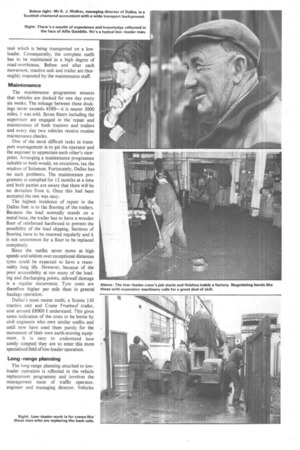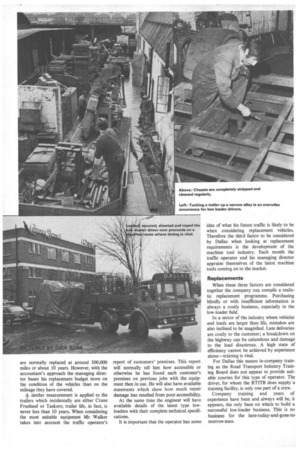mama
Page 78

Page 79

Page 80

If you've noticed an error in this article please click here to report it so we can fix it.
p Enst g ELI
'EN by lain Sherriff, MITA Sherriff, MITA
Low-loader work is a crew job and calls for a high degree of efficiency from both men and machines
WHEN Mr T. H. Campbell-Wardlaw, an eminent lawyer who has wide experience in traffic courts, addressed the London division of the Industrial Transport Association recently he suggested that the public sector of haulage had not fully grasped the full implications of operators' licensing (CM January 22).
Mr Campbell-Wardlaw described lowloader operators as "a very close corporation" who had guarded their traffic well under carriers' licensing. "This traffic," he pointed out, "is bound to attract many who have endeavoured to obtain carriers' licences for low-loaders under the old licensing system."
Some of the most hotly contested licence applications under the carriers' licensing system were made by public works contractors who could see an opportunity to use the spare capacity of their low-loaders on hire and reward work. Such applications normally were defeated on the grounds that existing operators had spare capacity. There is no reason to doubt that Mr Campbell-Wardlaw's assumption is correct but according to those already involved in low-loader operations there are grave doubts about the ability of newcomers to carry anything other than "run of the mill" earth-moving equipment.
One established operator who is confirmed in this opinion is Mr K. J. Walker, managing director of Dallas (Kingston) Ltd, New Malden, Surrey. He claims, and it appears with every justification, that low-loader operation on his type of traffic—mainly machine tools—demands training, long experience and team work. Dallas, which is part of Transport Development Group, began low-loader operation in 1955.
Mr Walker believes that every aspect of this specialized field is entirely different from general haulage (although 20 per cent of his total fleet is involved in general haulage). For the low-loader section overheads are greater, costs are higher, loads are moved by crews as opposed to one driver and each load has to be routed to the last mile and timed meticulously.
To support the claim that his overheads are higher, Mr Walker points out that four men were required in the 'traffic office in order to control the operation of 48 low-loader outfits. Each of these men draws on his practical experience in the organization when planning a movement, and with a heavy indivisible load this is a complex business.
As a job is booked over the telephone it can only be treated in the first instance as a tentative inquiry—snap quotations can be expensive. Following the 'phone call one of the company's three estimators examines the load, loading point and discharge point.
Mapping the route While this is happening the traffic clerk is mapping out the route, making allowances along the way for any height or width abnormalities. He estimates the running time and the field estimator calculates terminal delays, these are aggregated and a firm quotation is passed to the customer. Like the traffic clerks the estimators are also ex-operatives, usually drivers.
Having once worked out the route, which at this stage can still only be considered provisional, the traffic office then contacts the police traffic departments in each of the areas through which the load will pass. This must be done at least 48 hours before the job is due to start. Only when sanction has been granted by the police can the movement commence. "To reach this stage in the job, the training and the experience gained through long hours in actual operation play a vital part," says Mr Walker.
Mr Walker makes the point that it takes a team of experienced people to operate a low-loader business. Whereas in some other sectors of haulage an experienced manager can build a successful business with an inexperienced team, this is not so in this specialized work and certainly not so at Dallas.
The managing director of the company is a qualified chartered accountant and has been attached to general haulage companies within TDG. He is the first to admit that his experience of low-loader operation is limited compared to that of his staff but then his task is to lead the teatin and produce successful results.
Dallas's customers are, I understand, the most insurance-conscious people. Not the kind of people to pass work to an inexperienced operator. Mr Walker believes that established operators will be supported by their customers in ensuring that only qualified and experienced people handle their traffic.
As one machine can cost /50,000 the customer's concern over insurance is understandable. What is much more important, however, is the timing of the movement.
Delivery date The more flexible timing of general haulage cargoes cannot apply to low-loaders. These machines have been built to be installed into a factory production line. The machine builder has quoted his customer, sometimes 12 months in advance, not only a price but a delivery date and, with penalty clauses applying, it is essential that the date is achieved. It is here that the importance of well-planned traffic operation is highlighted.
Before the introduction of the new statutory drivers' hours on March 1 1970, planning low-loader movement was demanding enough. Many of the customers' requirements involved weekend work. This meant loading the machinery late on Fridays, transporting it and positioning it at its ultimate destination over Saturday and Sunday. In addition to customers' demands for weekend work it was frequently more convenient to move these abnormal loads through cities during the relatively quiet daylight hours of the weekend.
Now that the drivers' hours are set at 60 and one day off in every seven is a statutory obligation, the requirement for meticulous planning on low-loader operations is even more demanding. In this respect Dallas is fortunate because of the flexibility the company enjoys in its labour relations.
Drivers are prepared to act as fitters' mates in the workshop and for their part fitters are prepared to assist with driving duties. This co-operative attitude of the men permits flexibility in traffic operation and in some degree eases the extra burden imposed by the new hours. As Mr Walker points out, trained low-loader crews are not readily available on the labour market.
It is important to note that low-loader operation necessitates the use of crews as opposed to driver-only operation in general haulage. Sometimes as many as six men can be involved in one movement. On each occasion the crew has a working supervisor whose duty it is to see that the load is safely handled out of one factory, loaded on to the trailer so that it is in a roadworthy condition, unloaded and placed safely at its new location. Each member of the crew must be capable of taking over the duties of any other member at a moment's notice and without having to be instructed to do so.
Whereas a general haulage load on a more conventional type of vehicle can be transhipped in the event of a breakdown, the same cannot be said of a heavy machine tool which is being transported on a lowloader. Consequently, the complete outfit has to he maintained in a high degree of road-worthiness. Before and after each movement, tractive unit and trailer are thoroughly inspected by the maintenance staf.
Maintenance The maintenance programme ensures that vehicles are docked for one day every six weeks. The mileage between these dockings never exceeds 4500—it is nearer 3000 miles, I was told. Seven fitters including the supervisor are engaged in the repair and maintenance of both tractors and trailers and every day two vehicles receive routine maintenance checks.
One of the most difficult tasks in transport mamagement is to get the operator and the engineer to appreciate each other's viewpoint. Arranging a maintenance programme suitable to both would, on occasions, tax the wisdom of Solomon. Fortunately, Dallas has no such problem s. The maintenance programme is is compiled for 12 months at a time and both parties are aware that there will be no deviation from it. Once this had been accepted the rest was easy.
The highest incidence of repair in the Dallas fleet is to the flooring of the trailers. Because the load normally stands on a metal base, the trailer has to have a wooden floor of reinforced hardwood to prevent the possibility of the load slipping. Sections of flooring have to be renewed regularly and it is not uncommon for a floor to be replaced completely.
Since the outfits never move at high speeds and seldom over exceptional distances tyres could be expected to have a reasonably long life. However, because of the poor accessibility at too many of the loading and discharging points, sidewall damage is a regular occurrence. Tyre costs are therefore higher per mile than in general haulage operation.
Dallas's most recent outfit, a Scania 110 tractive unit and Crane Fruehauf trailer, cost around E8000 I understand. This gives some indication of the costs to be borne by civil engineers who own similar outfits and until now have used them purely for the movement of their own earth-moving equipment. It is easy to understand how sorely tempted they are to enter this more specialized field of low-loader operation.
Long-range planning
The long-range planning attached to lowloader operation is reflected in the vehicle replacement programme and involves the management team of traffic operator, engineer and managing director. Vehicles are normally replaced at around 300,000 miles or about 10 years. However, with the accountant's approach the managing director bases his replacement budget more on the condition of the vehicles than on the mileage they have covered.
4 similar measurement is applied to the trailers which incidentally are either Crane Fruehauf or Taskers; trailer life, in fact, is never less than 10 years. When considering the most suitable equipment Mr Walker takes into account the traffic operator's
report of customers' premises. This report will normally tell him how accessible or otherwise he has found each customer's premises on previous jobs with the equipment then in use. He will also have available statements which show how much repair damage has resulted from poor accessibility.
At the same time the engineer will have available details of the latest type lowloaders with their complete technical specifications.
It is important that the operator has some idea of what his future traffic is likely to be when considering replacement vehicles. Therefore the third factor to be considered by Dallas when looking at replacement requirements is the development of the machine tool industry. Each month the traffic operator and his managing director appraise themselves of the latest machine tools coming on to the market.
Replacements When these three factors are considered together the company cap compile a realistic replacement programme. Purchasing blindly or with insufficient information is always a costly business, especially in the low-loader field.
In a sector of the industry where vehicles and loads are larger than life, mistakes are also inclined to be magnified. Late deliveries are costly to the customer; a breakdown on the highway can be calamitous and damage to the load disastrous.. A high state of efficiency cannot be achieved by experience alone—training is vital.
For Dallas this means in-company training as the Road Transport Industry Training Board does not appear to provide suitable courses for this type of operator. The driver, for whom the RTITB does supply a training facility, is only one part of a crew.
Company training and years of experience have been and always will be, it appears, the only base on which to build a successful low-loader business. This is no business for the here-today-and-gone-tomorrow man.






































































































































































